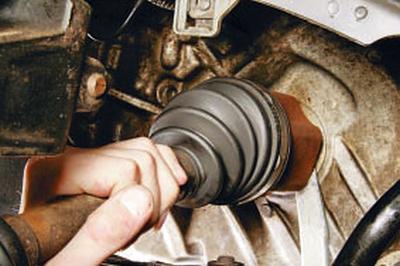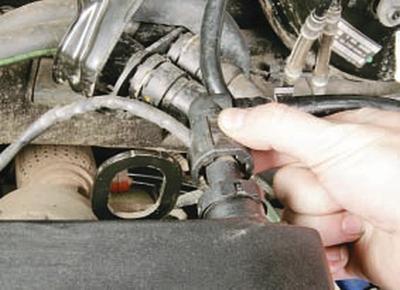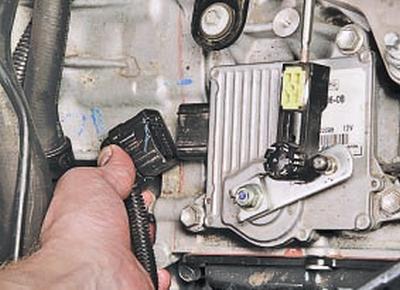This requires a lift to raise the front of the car higher. In garage conditions, in the absence of a lift, a jack will be required, as well as strong and high enough supports to install a raised front of the car on them, this will make it possible to remove the engine from under it, lowered to the garage floor.
GOOD ADVICE: The engine is very heavy, so we recommend removing it with help.
WARNING: When removing and installing an engine with a large mass, use only fully serviceable lifting mechanisms designed for the appropriate load, and especially carefully control the correctness and reliability of connecting cables, traverses, etc. to the transport eyes of the engine.
1. For convenience, remove the hood (see Removing and installing the hood).
2. Reduce the pressure in the engine power system (see Reducing the pressure in the engine supply system).
3. Disconnect the wires from the battery and remove it from the car (see Removing and installing the battery).
4. Remove the air supply sleeve (refer to Removing and installing the air filter and intake silencer).
5. Remove the air filter (refer to Removing and installing the air filter and intake silencer).
6. Remove the pipeline of the crankcase ventilation system (see Cleaning the Crankcase Ventilation System).
7. Remove the mudguard and crankcase protection (see Removal and installation of mudguard and crankcase protection).
8. Drain the liquid from the cooling system (see Coolant Change).
9. If you remove the engine for repair, drain the oil from the oil sump (see Engine Oil and Oil Filter Change).
10. Remove the cover of the mounting block in the engine compartment (see Removing and installing mounting blocks) and disconnect the block of the motor wiring harness from the block connector.
NOTE: The engine harness remains on the engine and will be removed with the engine.

11. Disconnect the ground wire from the body by unscrewing the fastening bolt.
12. Remove the battery mounting shelf (refer to Removing and Installing the Battery Shelf).
13. Disconnect from an arm of a body two "mass" wires.

14. Remove the expansion tank of the cooling system (see Removing and installing expansion tank).

15. Remove the front wheel drives (see Removing and installing front wheel drive).
16. Remove the A/C compressor drive belt.
17. Remove the accessory drive belt (refer to Inspection and Replacement of the Accessory Drive Belt).
18. Remove the radiator of the cooling system (refer to Inspection and Replacement of the Accessory Drive Belt).
NOTE: If the vehicle is not equipped with air conditioning, the radiator may not be removed. It is enough to disconnect the outlet hose from the lower radiator pipe.
19. Turn out bolts of fastening of the compressor of the conditioner (see Compressor Removal and Installation). Without disconnecting the pipelines from the compressor, take it to the side and secure it in any way possible (e.g. tying with wire).
20. Disconnect the power steering pump from the engine, and then, without disconnecting the pipelines from it, take it aside and fix it in the same way as the air conditioning compressor was fixed (refer to Power Steering Pump Replacement).

21. Using a puller or special tool, squeeze the clamps and disconnect the fuel supply pipe.

22. Disconnect the adsorber purge hose.
23. Remove the collector (see Removing and installing the manifold and replacing its gasket).
24. Disconnect the outlet hose of the interior heater radiator.
25. Disconnect the steam outlet hose, the interior heater radiator inlet hose and the cooling system radiator inlet hose from the water jacket outlet pipe.

26. Disconnect from an inlet pipe hoses of the vacuum amplifier of brakes and the valve of a purge of an adsorber.

27. Disconnect draft from the gear change lever.

28. Press a clamp and disconnect a block of plaits of wires from the switch of light of a backing.
29. Disconnect the hydraulic clutch release pipeline from the clutch housing (refer to Clutch Release Line Replacement).
30. Securely support the engine and remove the rear powertrain mount (refer to Powertrain Rear Mount Replacement).

31. Attach the slings of the hoist to the front and rear transport eyes and tension the slings.
32. Disconnect the left and right supports of the power unit (refer to Left Powertrain Mount Replacement Replacement of the right support of a suspension bracket of the power unit).
33. Check again that all wires, hoses and attachments are disconnected from the power unit.
34. Remove the support from under the engine and lower the power unit down to the floor.
35. Hang the front of the car (raise the car on a lift) to a height sufficient to remove the power unit from under the vehicle, and place reliable supports under the body.
36. Remove the power unit from under the car.
37. Install the engine, as well as all removed components and parts in the reverse order of removal, taking into account the following: - before installing the power unit, clean the threaded holes for fastening its supports with a tap from rust; – be sure to replace the gasket of the collector with a new one; - when connecting wires and pipelines, carefully monitor the correct location of them in the engine compartment, avoiding contact with heating and moving elements of the power unit.
After installing the engine, do the following.
1. Fill engine oil (see Engine Oil and Oil Filter Change).
2. Fill the gearbox with oil (see Manual Transmission Oil Change or Automatic Transmission Fluid Change).
3. Fill with coolant (see Coolant Change).
4. Adjust the gearbox control actuator (refer to Transmission Control Actuator Adjustment).
5. Remove air from the hydraulic clutch release (see Bleeding the hydraulic clutch release).
6. Start the engine and check for fuel, oil and coolant leaks. Check oil pressure. Listen to the engine: it should run smoothly, without extraneous noise and knocks.
Visitor comments